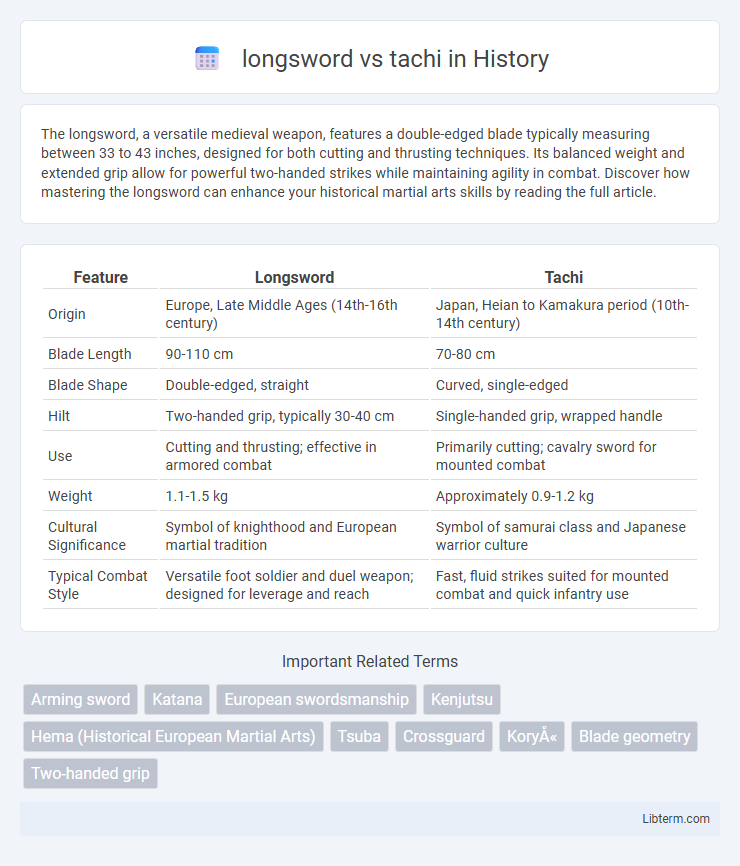The longsword, a versatile medieval weapon, features a double-edged blade typically measuring between 33 to 43 inches, designed for both cutting and thrusting techniques. Its balanced weight and extended grip allow for powerful two-handed strikes while maintaining agility in combat. Discover how mastering the longsword can enhance your historical martial arts skills by reading the full article.
Table of Comparison
| Feature | Longsword | Tachi |
|---|---|---|
| Origin | Europe, Late Middle Ages (14th-16th century) | Japan, Heian to Kamakura period (10th-14th century) |
| Blade Length | 90-110 cm | 70-80 cm |
| Blade Shape | Double-edged, straight | Curved, single-edged |
| Hilt | Two-handed grip, typically 30-40 cm | Single-handed grip, wrapped handle |
| Use | Cutting and thrusting; effective in armored combat | Primarily cutting; cavalry sword for mounted combat |
| Weight | 1.1-1.5 kg | Approximately 0.9-1.2 kg |
| Cultural Significance | Symbol of knighthood and European martial tradition | Symbol of samurai class and Japanese warrior culture |
| Typical Combat Style | Versatile foot soldier and duel weapon; designed for leverage and reach | Fast, fluid strikes suited for mounted combat and quick infantry use |
Introduction: Comparing the Longsword and Tachi
The longsword, a European weapon prominent from the late medieval to Renaissance periods, features a straight double-edged blade designed for versatile cutting and thrusting techniques. The tachi, a Japanese curved sword used primarily by samurai before the katana era, excels in swift, slashing motions and is recognized for its distinct curvature and mounting style. Both swords reflect their respective cultures' combat styles, with the longsword emphasizing reach and versatility while the tachi prioritizes speed and cutting efficiency.
Historical Origins and Evolution
The longsword emerged in Europe during the late medieval period, particularly between the 13th and 15th centuries, evolving as a versatile weapon for both armored and unarmored combat. The tachi, originating in Japan's Heian to Kamakura periods (10th to 14th centuries), served as a cavalry sword with a distinctive curved blade designed for swift, slashing strikes. Over time, the longsword developed from earlier Viking and Roman sword styles, while the tachi influenced the later katana, reflecting distinct cultural and martial traditions shaping their design and use.
Design and Blade Geometry
The longsword features a straight, double-edged blade typically measuring 33 to 43 inches, designed for versatile cutting and thrusting with balanced weight distribution and a cruciform hilt for two-handed grip. In contrast, the tachi presents a curved, single-edged blade averaging 27 to 31 inches, optimized for slashing strokes from horseback with a pronounced curvature and a lighter, slender profile that enhances maneuverability. The blade geometry of the longsword emphasizes rigidity and versatility, while the tachi's curvature aids in draw cuts and swift, fluid motions.
Weight, Balance, and Handling
Longswords typically weigh between 2.5 to 3.5 pounds with a balanced center near the hilt, allowing for versatile handling and effective thrusting. The tachi, usually lighter at around 2 to 3 pounds, features a curved blade with a balance shifted slightly towards the blade tip, enhancing cutting power and slashing techniques. Weight distribution differences affect maneuverability, with the longsword favoring a stable, controlled grip and the tachi excelling in swift, fluid motions suited to cavalry use.
Techniques and Fighting Styles
Longswords employ versatile techniques such as thrusts, cuts, and half-swording, emphasizing fluid motion, leverage, and grappling in close combat. Tachi techniques prioritize swift, slashing strikes from horseback, using the curved blade's cutting power enhanced by mounted combat dynamics. The longsword's fighting style excels in both armored and unarmored duels on foot, while the tachi is optimized for mobile, cavalry engagements with rapid draw and strike maneuvers.
Armor, Opponents, and Battlefield Use
Longswords were effective against lightly armored opponents and excelled in close-quarter combat, allowing versatile strikes and thrusts ideal for battlefield mobility. Tachi swords, traditionally used by mounted samurai, were optimized for slashing armored warriors thanks to their curved blade and superior cutting ability. Both weapons adapted to specific combat scenarios, with longswords favoring foot soldiers on diverse terrains and tachi dominating cavalry engagements on open fields.
Cultural Significance and Symbolism
The longsword symbolizes the chivalric ideals of medieval Europe, representing knightly honor, justice, and martial prowess in Western culture. The tachi, a Japanese curved sword worn edge-down, holds deep ties to the samurai class, embodying loyalty, discipline, and the bushido code. Both weapons reflect their societies' values, serving as powerful symbols of social status and warrior ethos in their respective cultures.
Craftsmanship and Materials
Longswords feature high-carbon steel blades forged through meticulous folding techniques, providing a balanced combination of flexibility and hardness essential for durability and sharpness. Tachi swords, crafted primarily from tamahagane steel, undergo differential hardening via clay coating, resulting in distinct hamon patterns and enhanced cutting performance. The intricate craftsmanship of tachi emphasizes elegance and curvature, optimizing speed and slicing efficiency, whereas longswords prioritize robust construction suited for versatile combat.
Modern Practice and Martial Arts
Modern practice of longsword and tachi emphasizes distinct martial arts traditions, with the longsword commonly studied in Western Historical European Martial Arts (HEMA) and the tachi in traditional Japanese kenjutsu schools. HEMA practitioners analyze historical manuals to reconstruct longsword techniques focusing on cutting, thrusting, and half-sword techniques for armored combat simulation. In contrast, tachi training prioritizes fluid, precise cutting and drawing motions rooted in classical samurai etiquette and battlefield effectiveness.
Conclusion: Strengths and Weaknesses of Each Blade
The longsword excels in versatility and reach, offering balanced offensive and defensive capabilities suitable for both cut and thrust techniques, while its straight blade provides precision in European martial arts. The tachi, characterized by its curved design and lighter weight, delivers superior slashing power and speed, optimized for fast horseback combat in feudal Japan but less effective for thrusting. Each blade's strengths reflect their cultural origins and combat styles: the longsword favors adaptability on foot, whereas the tachi prioritizes agility and cutting efficiency on mounted warriors.
longsword Infographic

 libterm.com
libterm.com